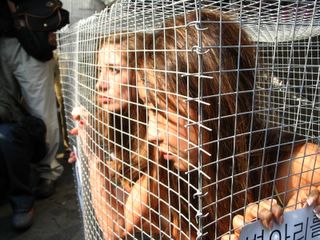The Apple Experience in Seoul
Tuesday, April 11th, 2006
Today I had some time to kill and made my way to COEX, a giant mall in southern Seoul where there is an Apple Computer store.
It is aptly named “The Apple Experience.”
Here’s my Apple experience.
When I walked in the spacious, brightly lit, distinctly Apple-esque store I asked the guy at the front counter if he spoke English and if he could answer some questions about my iPod. He told me no, and pointed me to the Help Desk around the corner.
I walked over and sat in the small waiting area along with a few other people — all with their iPods. Each of the others were called up and taken care of in a few moments. I suppose they may have been simply asking how a function on the iPod worked.
When it was my turn I walked up carefully, almost tentatively. I worried the Apple-certified help guy wouldn’t understand English. And if he didn’t, I wouldn’t be surprised or upset by it. But as I approached, Mr. Ko, as his name tag read, said “How may I help you?”
Whew, I thought. Relief.
“First I want to tell you I love my iPod,” I said as a preface, assuming he would take my complaints personally. I guess because I was about to unload on him my three problems with the sexy little gadget I wanted to make sure he knew I wasn’t completely unsatisfied.
“But…” I began. “The battery dies after only three hours, the memory claims to be 30 gigabytes, but is only 27.8 gigabytes, and the screen is all scratched up after only two weeks.” This was all said in my “Native-English-speaker-talking-to-a-Korean-with-a-minimal-working-understanding-of-English-and-a-need-for-slow-and-ennunciated-speech” tone.
He asked me what format it was and then hooked it up to the Windows-based laptop in front of him and ran some diagnostics. I made small talk and told him I would buy a Mac in six months or so and then change the format to Mac and reload my music. He nodded at this and then told me the tests had shown that my sleek, black media player was healthy.
Without asking me, he then hooked up my iPod to the Mac laptop and ran what I thought was some other test. When he was done he handed it to me and said, “There, now it is formatted for your new Mac.”
“WHAT? Are you kidding? Why did you do that?” I screeched.
“You say you have new Mac,” he replied defensively.
“I said I WANT a new Mac, but not yet.”
“Oh,” he said and paused for a minute while his error sunk in. “I am sorry. I will change it back.”
“Thank you,” I replied, relieved he was going to fix his error.
“But,” he added. “You will have to reload all of your music again. It has been erased.”
All I could do was laugh. I had come in to buy a protective rubberized case for my iPod and ask a few questions about the machine and was leaving — so far — with an empty iPod which I wouldn’t get to enjoy on my one-hour commute back to Hongdae.
But my Apple Experience didn’t end there.
I found the case I wanted and saw that it cost 35,200 won. So I left the store and found an ATM to get a little money and go back.
When I placed the case on the counter, the guy scanned it and smiled at me. He was the same guy who didn’t speak English earlier and decided it wouldn’t be worth trying any Korean on me. What he didn’t know was that money was the only Korean I was fluent in. You really can’t survive if you don’t understand how many won something costs.
The screen for the cash register wasn’t facing me so I handed him four 10,000 won notes. He opend the drawer and gave me back 200 won. I was owed 4,200. When I aksed him where the rest of my money was, he showed me the receipt for 29,800 won.
Shit. How will I explain this?
“I gave you sa man won,” I said. (40,000 won)
“Ne. Sam man won,” he replied. (Yes. 30,000 won)
“Anio. SA man won. (No. 40,000 won) The price there says Sam man o chun ee bek won (35,200 won),” I said and pointed at the sign on the shelf. “So I give you SA MAN WON.”
At this point a young girl who worked there and spoke some English came up and asked what the problem was. There was no anger between us, only confusion. I already had a blank iPod, why would getting ripped off $10 bother me now?
I showed her the receipt for the case and explained that I had gotten 70,000 won out of the bank and only had 30,000 left and showed her that receipt and the money as well. She nodded sympathetically and touched the screen on the cash register and brought something up.
Then the guy says in English, “I must count money. Please wait.” He then proceeded to run all the bills through a counting machine and add it up on a calculator — twice.
The count came out in my favor. He handed me 10,000 won and said he was sorry.
I accepted his apology and asked the girl to hand me the case I had just purchased so I could go. She told me they had made an error and re-rung it. Then she asked me for 35,200 won!
“You already have 29,800 won,” I said, exasperated by now. She shook her head and gave me that dismissive wave Koreans give when they think someone is wrong.
So I did what Koreans do to me when I don’t understand their provincial accents or their mouths stuffed with food: I took the calculator and typed in 40,000, subtracted 35,200, and handed them 5,000 won. The girl smiled and took my money and gave me another small pile of coins in return.
And as I walked out the door the man called out to me his favorite phrase in English:
“Have a nice day.”



 Enchiladas at Margarita Bar & Grill
Enchiladas at Margarita Bar & Grill





